Salmon & Trout
Anadromous Fish of the Dungeness
“Anadromous” means fish which hatch in freshwater, spend a large portion of their life in the ocean, and return to freshwater to spawn. The Dungeness River is home to nine different “salmonid” species (meaning that they are / are like salmon), including Pink, Chum, Chinook, Coho, and Sockeye Salmon; Steelhead/Rainbow Trout, Cutthroat, Dolly Varden, and Bull Trout. The fish in the salmonid family all have an adipose fin on their backs between their dorsal fin and tail; abdominal pelvic fins on their belly; and they have life cycles which fit the anadromous pattern.
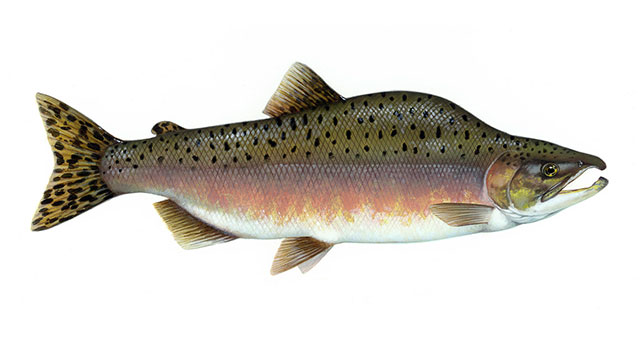
Pink Salmon
Scientific name:
Oncorhynchus gorbuscha (Oncorhynchus = hooked nose, and Gorbuscha is the native Russian name for the species)
Other names:
Humpback salmon, or “Humpies.”
Pink salmon are the smallest of the Pacific salmon, usually weighing no more than five to seven pounds. They have heavily spotted backs over silvery bodies. When spawning they turn a pale gray with white bellies. Male pink salmon develop an extremely humped back when spawning.
The most abundant of the five species of Pacific salmon, pink salmon have two populations, or stocks, which return to the Dungeness River each year. The summer run of adult salmon enters the river beginning in July and swims to the upper half of the river to spawn. Spawning begins in August and continues into mid-September.
Spawning
The fall pinks enter the river in September and they spawn in the lower three miles of the river. Spawning is normally complete by the end of October. All pink salmon die after they spawn.
Dungeness pink salmon all spawn as 2-year-old adults and their spawning years are two years apart. Most Puget Sound pink salmon spawn in odd-numbered years only.
Young pink salmon emerge from the gravel in April and May. When they reach the fry stage, they immediately swim downstream to saltwater. After leaving the Dungeness River, pink salmon fry may spend several months near shore once they reach salt water.
Population Concerns
Pink salmon populations are not considered endangered in the Dungeness River, although their populations are lower than they should be. Several hundred thousand pinks spawned in the river as recently as the 1960s, but fewer than 20,000 have spawned during most of the last 30 years.

Chum Salmon
Scientific name:
Oncorhynchus keta; (Oncorhynchus = hooked nose, keta = native name for species inKamchatka, Russia)
Other names:
Dog salmon, Calico salmon, or Dogs.
The second most numerous species of Pacific salmon, chum salmon exist in the Dungeness as two stocks, a summer run and a fall run. The summer chum population is thought to be very small. Little is known about this stock except that adult fish are observed in the river during the late summer.
Chum salmon reach 8 to 20 pounds in 3 to 4 years. They have black specks over silvery sides, with faint grid-like bars. When spawning, chum have wide vertical bars on their sides in olive to greenish-red. Males develop an extremely hooked nose with big dog-like teeth; that’s where they got the name of “dog” salmon. Because of its squishy texture, fresh chum salmon meat is considered less desirable than other salmon, so in Alaska it was typically boiled and fed to sled dogs, which is another reason for the name “dog” salmon.
Spawning
Fall chum enter the Dungeness in October and November with spawning taking place from November into January. All chum salmon die after spawning. Adult chum are typically three, four and sometimes five years old. Chum fry in the Dungeness migrate to the sea soon after they hatch and leave the gravelly river bed. Some chum fry may migrate with the pink salmon fry which emerge at similar times. Others may spend several weeks in the freshwater, depending on flow conditions they encounter. Chum fry form schools in salt water. They remain near shore for several months. Fry going into deeper salt water off shore takes place throughout the summer.
Population Concerns
The Dungeness summer chum stock, along with other Hood Canal summer chum, is listed as “threatened” on the Endangered Species List. The fall run is not currently on that list. Less than 1000 chum have spawned in the river during recent years.
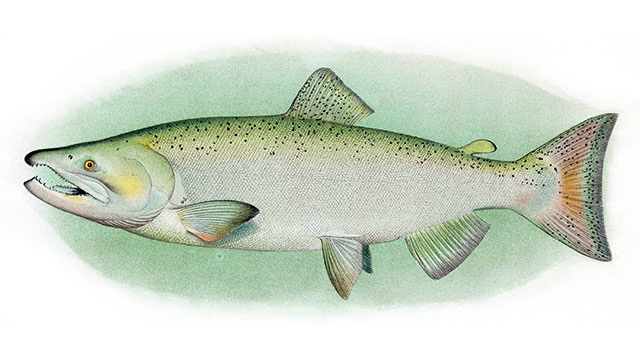
Chinook Salmon
Scientific name:
Oncorhynchus tshawytscha (Oncorhynchus = hooked nose, tshawytscha = native name for species in Kamchatka, Russia)
Other names:
King salmon, Springer salmon, Kings, Tyee, Springers. blackmouth, blacks.
Chinook salmon are the largest of the Pacific salmon, earning the name “king salmon.” In the Dungeness, adult Chinooks enter the river from May through July; the stock is therefore labeled spring/summer run Chinook. In other rivers, Chinook may occasionally weigh 50-100 pounds and be over five feet long, but Dungeness fish are much smaller. Black gums, along with large spots on the back, dorsal fin, and tail, distinguish the Chinook from other salmon. In the Dungeness, Chinook change very little during spawning, other than a slight darkening of the body.
Spawning
Spawning takes place in the main part of the river starting in August, upstream, and into early October downstream, peaking in September. All Chinook salmon die after spawning. The age of adult Chinook typically varies from three to five years with some six-year-old fish.
Chinook fry migration patterns are varied. Some fry may migrate to sea not long after they hatch. Others migrate slowly downstream to the lower river where they spend the summer months. Another type of Chinook spends an entire year in freshwater, migrating to sea the following spring as yearlings. Newly emerged Chinook fry are often found in small schools, but as they grow bigger they become more territorial and aggressive.
Population Concerns
Dungeness Chinook are listed as threatened on the Endangered Species List. Historically, it is thought that 8000 to 10,000 Chinook may have spawned in the Dungeness prior to 1850s, but now just a few hundred spawn in the river.
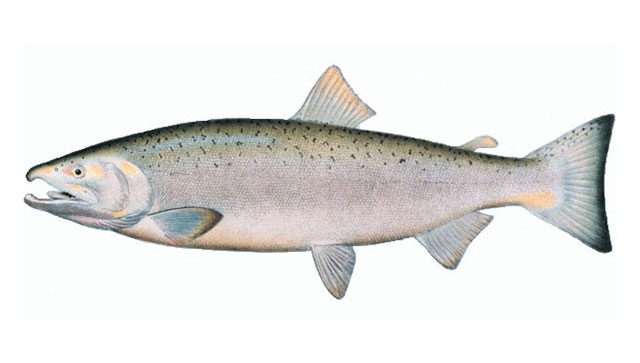
Coho Salmon
Scientific name:
Oncorhynchus kisutch (Oncorhynchus = hooked nose, kisutch native name for species in Kamchatka,Russia)
Other names:
Silver salmon, Blueback, Silvers
Coho salmon are common to most rivers and streams in westernWashington. The Dungeness River is home to both a natural population and a large hatchery population of coho. Adults return to the Dungeness River starting in September and continue through November.
Coho adults reach weights of six to 22 pounds. In the ocean and when entering the river they are bright silver with a few spots on the upper tail and back. During spawning, coho (particularly the males) turn reddish on their sides, bluish-green on the head, and develop large, hooked noses.
Spawning
Wild spawning takes place from October through January, largely in side channels and tributaries filled by fall rains. The vast majority of spawning coho are three and four year olds, who spent one year in freshwater and one to two years in saltwater. All coho adults die after spawning.
Like many salmon in the Dungeness, young coho emerge from the gravel in early spring. Coho fry do not migrate to sea until they are one-year-old. Migration occurs in the first year within the same river or stream where they hatched and their journey is influenced by water flow conditions.
Population Concerns
The Dungeness coho population is supported by the Dungeness Fish Hatchery, which plants several hundred thousand fry into the river each year. Coho is not listed on the Endangered Species List and is the only salmon species legally fished in the Dungeness. The fishing season typically runs from mid-October to the end of December.
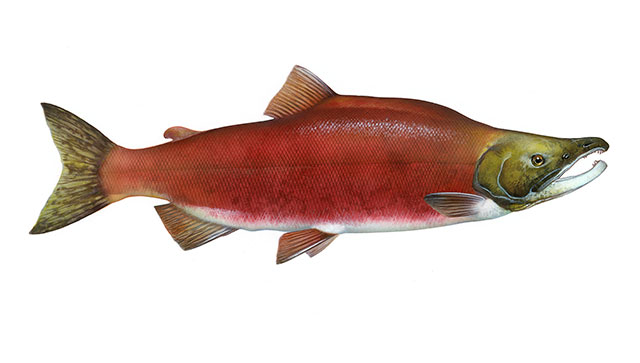
Sockeye Salmon
Scientific name:
Oncorhynchus nerka (Oncorhynchus = hooked nose, nerka = Russian name for the species)
Other names:
Red salmon, Blueback salmon, Reds
Sockeye salmon are found in the Dungeness River in very small numbers, since their fry typically require lakes during their first year of life and no accessible lakes exist in the Dungeness watershed.
Adult sockeye turn bright red on their sides when spawning, along with greenish heads. An endangered stock uses Lake Ozette on the west side of the Olympic Peninsula, but in the Dungeness sockeye are not listed as endangered.
Spawning
Like many rivers on the Olympic Peninsula, the Dungeness is home to a tiny handful of spawning sockeye each year. It is not known whether these fish are strays from a larger group such as those in the Fraser River, or if they are a very small group on their own. These sockeye usually spawn in upstream locations in early September. All sockeye salmon die after they spawn. Little is known about these “river run” sockeye except that the adults seem to be present each year at about the same time and use the same general area of river to spawn.
In freshwater, sockeye commonly require a lake where newly emerged fry spend a year growing to smolt size, then migrate to sea from May through July. Adults normally spend two to three years in the ocean and return as four or five-year-old adults.
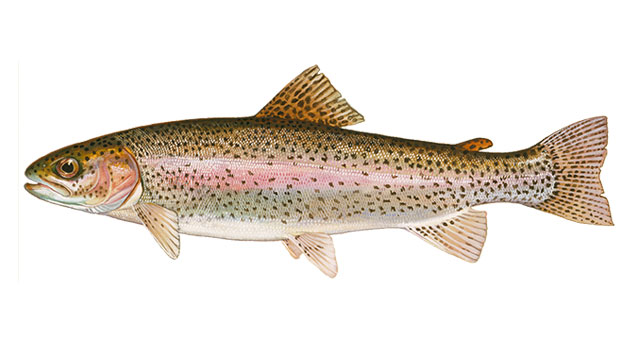
Steelhead Trout
Scientific name:
Oncorhynchus mykiss (mykiss = native name for sea-run species in Kamchatka)
Other names:
Steelhead trout, Rainbow trout, Searun rainbow, Coastal rainbow, Metalhead, Steelies
Steelhead were once categorized as sea-run trout rather than salmon, but are actually closely related to the other Oncorhynchus species. The notable difference is that unlike their salmon cousins, not all steelhead die after they spawn. Juvenile steelhead spend a considerable amount of their lives in freshwater. Most steelhead spend two years in freshwater and from one to three years in saltwater. Juvenile steelhead seek out relatively swift, cool, clean water. They migrate to sea as relatively large smolts, 6 to 10 inches long. As adults, they are silver colored, reaching weights of ten pounds or more.
Spawning
There are two runs of steelhead in the Dungeness, a summer run and a winter run. The summer run enters the river from May through October and spawns in late fall and winter. The winter run enters the river from November through May and spawns from January through June. They spawn throughout the main stem of the river. A portion of the spawning adults, as much as 25% in some populations, live to spawn again the following year. Some steelhead live long enough to spawn three or four different times.
Population Concerns
Dungeness steelhead are not listed under the Endangered Species Act, however the population is very depressed and listing may occur.
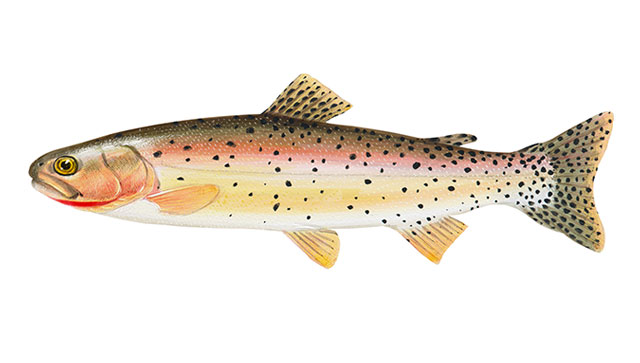
Cutthroat Trout
Scientific name:
Oncorhynchus clarki (Oncorhynchus = hooked nose, clarki = named after Captain William Clark of the Lewis and Clark expedition).
Other names:
Cutthroat trout, Searun cutthroat, Coastal cutthroat, Red-throated trout, Sea trout, Blueback, Cuts
Cutthroat are another species commonly considered a sea-run trout. Cutthroat are closely related to salmon and share the same genus, “Oncorhynchus.” Cutthroat trout do not always die after spawning. They are often found in estuaries at or near the mouth of their home rivers, indicating some portion of the population does not migrate very far into the saltwater.
Adult cutthroat have a reddish-orange slash on the underside of their jaw, hence the name cutthroat. They are variable in color with many spots that become more densely grouped towards their tails
Spawning
Adult cutthroat enter the river from September through November and spawn mostly during the winter months in small gravelly streams. Juvenile cutthroat spend the bigger part of their lives in freshwater. It may take two to three years before a cutthroat migrates to sea, commonly achieving a large smolt size (8 to 12 inches) before doing so. Cutthroat may spend over one year in the sea but some may spend only a few months. Some cutthroat may never leave the influence of their home river, spending the marine portion of their lives in the estuary. Cutthroat are highly predatory and they may consume large numbers of salmon fry and smolt in the lower river and estuary.
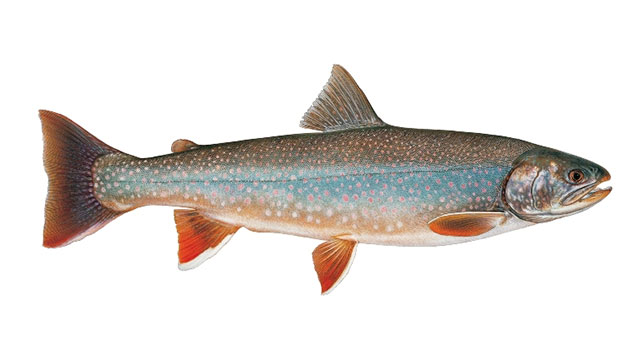
Dolly Varden/Bull Trout
Scientific name:
Salvelinus malma (salvelinus is an old name for char; and malma is the native name for species in Kamchatka, Russia). Salvelinus confluentus (confluentus may indicate the close relationship of bull trout to Dolly Varden)
Other names:
Dollies, Char, Bull trout
Dolly Varden and bull trout, both native char, are very closely related to each other and both are found in the Dungeness. Bull trout require especially high quality, cold water like that found in theDungeness River system.
In the Dungeness, Dolly Vardens are apparently resident in the upper river, whereas bull trout are anadromous, spending one year in the estuary, where fresh and salt water meet, before returning to freshwater to spawn. Bull trout and Dolly Varden are highly predatory fish; their anadromous migration patterns may enable them to pursue juvenile salmon.
Bull trout have olive green to brown coloration with crimson or cream-colored spots on their sides.
Spawning
Anadromous adults, typically four to six years old when first spawning, migrate to the home river in August and September. Native char spawn in the fall when water temperatures drop to nearly 46 degrees F. Adults do not die after spawning but may be in poor condition. They move downstream and spend their winter in deep pools of the main river. Some anadromous native char may survive to be 10 years old.
Juveniles emerge in the spring and grow fairly rapidly in spring and summer but slowly in the fall and winter. Smolts migrate in May and June as three to four year olds and range in size from four to eight inches. Like many cutthroat, anadromous Bull Trout may spend much of their time in the marine environment near their river of origin. Little is known about the full extent of the marine migration of anadromous, native char.
Population Concerns
Bull trout are listed as threatened on the Endangered Species List throughout their North American range.

